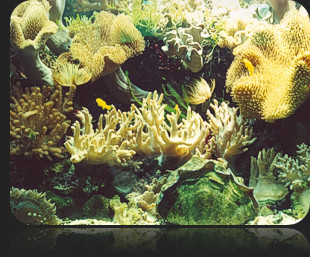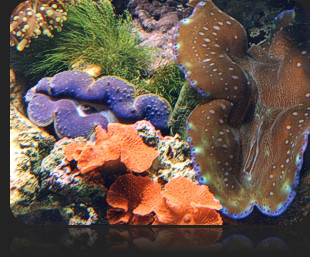 |
home page Aquarium Adventure carries the widest selection of aquariums, fish, corals & plants. |
| ABOUT USAQUATIC PROFESSIONALSLOCATIONSTIP SHEETSFRANCHISE |
 |
||
| We offer everything from do-it-yourself pond equipment and starter sets to full custom installation packages. Our experts can answer those really tough questions about installing and maintaining garden ponds...a service the hardware stores cannot provide. Come visit our store and take a tour! |
||
 |
||
 |
||
|
||
 |
||
Bring some of this rich underwater nature into your own environment with a saltwater reef aquarium. Due to advances in technology and equipment, it has now become easier than ever to set up a reef aquarium. At Aquarium Adventure, we have put together a very simple and highly successful procedure for establishing a saltwater reef. Our method consists of an aquarium, strong lighting, water pumps, protein skimmer, mechanical filter, saltwater, and our key ingredient—live rock. Setting Up the Saltwater Reef Aquarium
Install and begin operating the protein skimmer, mechanical filter, and/or sump, heater and lights to the reef system. The skimmer, filter and heater should run constantly, however the lights should be plugged into a timer. By using a timer and a predetermined program, daylight and nighttime can be recreated, automatically. Allow the aquarium to run for 24 hours so that water can mix and clear, substrate can settle and filters, heaters and lights operate consistently. At this stage, the filters, pumps and skimmer can be turned off, so the key ingredients, the live rock may be added. The live rock is the most important element of the marine reef aquarium. Live rock is actual rubble rock from the ocean’s reefs that have tumbled to the bottom of the reef or washed up on shore due to wave action. It is very beneficial and essential for maintaining the aquarium water quality. It is loaded with good bacteria, zoo plankton and phytho plankton all necessary for the filtration process of the reef aquarium. The rock should be stacked to create a reef appearance and to provide lots of nooks and crannies for fish and invertebrates to call home. After the environment is created by placing all the live rock, the pumps, filters and skimmer can be restarted. The water pumps may need to be re-positioned within the live rock in order to get good water circulation throughout the reef that has been designed.
As with any aquarium set-up, options are available for different looks and sizes from beginner to hard-core hobbyist. Added equipment components can increase the quantity and diversity of animals, as well as effect animal reproduction and growth rate. There is also a wide selection of colors and types of “live ocean rock” to create different types of reefs. Ask you Aquarium Adventure Fish Specialist to review with you, all of the options.
View All Fish Keeping Tip Sheets
|
||||||||

 Saltwater Reef Aquariums
Saltwater Reef Aquariums Now add several water pumps to the aquarium in order to circulate and mix the water and provide the reef with currents. Place in the bottom of the aquarium, the substrate, rinsed to be free of dust. The substrate should be made of calcium carbonate so that it will help with buffering the water, maintaining an alkaline pH.
Now add several water pumps to the aquarium in order to circulate and mix the water and provide the reef with currents. Place in the bottom of the aquarium, the substrate, rinsed to be free of dust. The substrate should be made of calcium carbonate so that it will help with buffering the water, maintaining an alkaline pH. 48 hours later, this “beginning” reef aquarium will stabilize. Test the water in the aquarium for ammonia and nitrites during the next 4-6 days. When test readings are safe then fish and invertebrates can be added slowly to the aquarium. Over a period of time, this reef will begin to flourish. It’s easy and simple!
48 hours later, this “beginning” reef aquarium will stabilize. Test the water in the aquarium for ammonia and nitrites during the next 4-6 days. When test readings are safe then fish and invertebrates can be added slowly to the aquarium. Over a period of time, this reef will begin to flourish. It’s easy and simple!